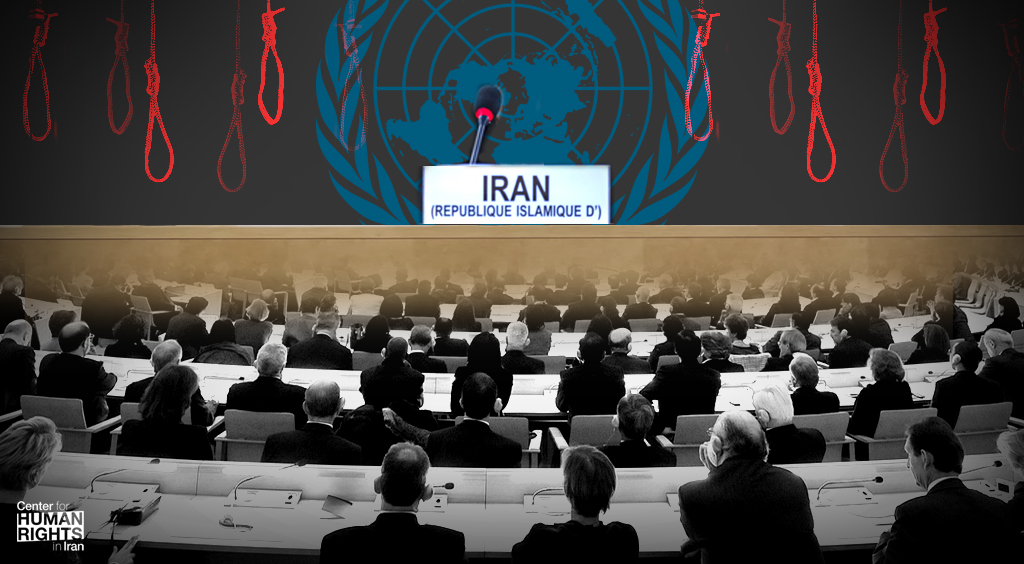UN: Iran’s Surge in Unlawful Executions May Amount to Crimes Against Humanity – Center for Human Rights in Iran

Report on the Deterioration of Human Rights in Iran and its Implications for Sustainable Development Goals (SDGs)
Introduction
This report, based on findings from the Independent International Fact-Finding Mission on the Islamic Republic of Iran, outlines a severe deterioration of the human rights situation following external hostilities and a subsequent domestic crackdown. These events represent significant setbacks for Iran’s progress towards multiple Sustainable Development Goals (SDGs), particularly SDG 16 (Peace, Justice and Strong Institutions), SDG 5 (Gender Equality), and SDG 10 (Reduced Inequalities).
Impact of Hostilities on Civilian Life and Infrastructure: A Setback for SDGs 3, 4, and 16
Casualties and Damage to Essential Services
The Israeli airstrikes from 13 to 25 June 2025 have directly undermined SDG 16.1 (Significantly reduce all forms of violence and related death rates). The consequences include:
- Approximately 1,100 people killed, including 276 civilians.
- Civilian casualties included 38 children and 102 women.
- Over 5,600 individuals were injured.
- Civilian infrastructure, including medical facilities and schools, was impacted, hindering progress on SDG 3 (Good Health and Well-being) and SDG 4 (Quality Education).
Iran’s missile strikes against Israel, which resulted in 31 deaths and over 3,300 injuries, further contributed to the cycle of violence, moving the region further from the aims of SDG 16.
Targeted Attack on Evin Prison
A targeted airstrike on Evin prison in Tehran on 23 June resulted in the deaths of approximately 80 people, including prisoners, family members, and at least one child. Preliminary investigations suggest the intentional striking of civilian buildings within the prison complex, a grave violation of international law and the right to life, which is a cornerstone of SDG 16.
Erosion of Justice and Institutional Integrity: Contravening SDG 16
Failure of State Protection and Due Process
The state’s response following the Evin prison attack demonstrates a failure to uphold its obligations under SDG 16.3 (Promote the rule of law and ensure equal access to justice) and SDG 16.6 (Develop effective, accountable and transparent institutions).
- Authorities failed to take reasonable measures to protect prisoners, with some reportedly beaten and threatened during transfers.
- Families were denied information regarding the location of their relatives for extended periods.
- At least one woman died due to the denial of medical care after being transferred, a violation of SDG 3 (Good Health and Well-being).
- There is an urgent need for an independent and transparent investigation to ensure accountability.
Domestic Crackdown and Suppression of Fundamental Freedoms
A stark increase in domestic repression has severely undermined SDG 16.10 (Ensure public access to information and protect fundamental freedoms). Measures include:
- The arrest of 21,000 “suspects” by mid-August, including lawyers, journalists, and human rights defenders.
- Calls by the Judiciary for expedited trials against individuals accused of “collaborating with Israel.”
- New legislation expanding the use of the death penalty for “espionage” and criminalizing social media content deemed “false information.”
Rise in Executions and Systemic Impunity
Executions in Iran have reached their highest level since 2015, a direct contravention of the right to life and SDG 16.1. The Fact-Finding Mission notes that most investigated death penalty cases violate international human rights law. Such actions, if part of a widespread and systemic attack against a civilian population, may constitute crimes against humanity, holding those responsible, including judges, accountable.
Escalation of Inequality and Gender-Based Violence: Undermining SDGs 5 and 10
Persecution of Ethnic and Religious Minorities
The recent repression has disproportionately affected minority groups, representing a regression on SDG 10 (Reduced Inequalities).
- Over 330 Kurds and large numbers of Arabs have been arrested.
- Hundreds of thousands of Afghans have been deported.
- Members of the Baha’i religious minority have been accused of espionage, arrested, and had their property confiscated.
Gender-Based Discrimination and Violence
The situation for women and girls has worsened, in direct opposition to the goals of SDG 5 (Gender Equality).
- Over 60 cases of femicide were reported between March and September 2025, reflecting a culture of impunity for “honour killings” and other forms of gender-based violence.
- Legal reforms to prevent violence against women have stalled, undermining SDG 5.2 (Eliminate all forms of violence against all women and girls).
- Enforcement of mandatory hijab laws has intensified, with the closure of non-compliant businesses and the reported return of the “morality police.”
Transnational Repression: A Global Challenge to SDG 16
Extra-territorial Intimidation
The Mission has documented increasing cases of transnational repression, which violate Iran’s obligation to respect freedom of expression and threaten rights to life and security beyond its borders. This global intimidation campaign is a challenge to the principles of SDG 16.10. Credible information indicates that more than 45 journalists in seven countries have faced threats for their reporting on events in Iran.
Conclusion: Systemic Repression and the Denial of Justice
The findings indicate a recurring system of repression underpinned by systemic impunity. The failure to address injustice and ensure accountability, truth, and reparations violates Iran’s obligations under international human rights law and fundamentally obstructs progress towards achieving the Sustainable Development Goals, most notably SDG 16, which is foundational for peaceful, just, and inclusive societies.
Analysis of Sustainable Development Goals in the Article
1. Which SDGs are addressed or connected to the issues highlighted in the article?
The article highlights several issues that directly connect to multiple Sustainable Development Goals. The primary SDGs addressed are:
- SDG 16: Peace, Justice and Strong Institutions: This is the most prominent SDG in the article, which focuses on violence, conflict, lack of due process, arbitrary arrests, executions, and the persecution of journalists and human rights defenders.
- SDG 5: Gender Equality: The article specifically discusses violence against women, including femicide, “honour killings,” and discriminatory practices like the mandatory hijab laws and the “morality police.”
- SDG 3: Good Health and Well-being: The impact of airstrikes on medical facilities and the denial of medical care to a prisoner directly relate to this goal.
- SDG 4: Quality Education: The article mentions that schools were among the civilian objects impacted by airstrikes, which undermines the provision of safe learning environments.
2. What specific targets under those SDGs can be identified based on the article’s content?
Based on the issues discussed, the following specific targets can be identified:
SDG 16: Peace, Justice and Strong Institutions
- Target 16.1: Significantly reduce all forms of violence and related death rates everywhere. The article details deaths from airstrikes, missile strikes, and a rising number of executions, directly addressing this target.
- Target 16.3: Promote the rule of law at the national and international levels and ensure equal access to justice for all. The text describes a domestic crackdown, expedited trials, denial of due process, and systemic impunity, which are all antithetical to this target.
- Target 16.10: Ensure public access to information and protect fundamental freedoms, in accordance with national legislation and international agreements. The arrest of journalists, human rights defenders, and individuals for social media posts, along with transnational repression of journalists, directly relates to the violation of this target.
SDG 5: Gender Equality
- Target 5.1: End all forms of discrimination against all women and girls everywhere. The enforcement of mandatory hijab laws, the closure of businesses serving non-compliant women, and the return of the “morality police” are forms of systemic discrimination.
- Target 5.2: Eliminate all forms of violence against all women and girls in the public and private spheres. The article explicitly mentions a high number of femicide cases, impunity for “honour killings,” and stalled legal reforms to prevent gender-based violence.
SDG 3: Good Health and Well-being
- Target 3.d: Strengthen the capacity of all countries… for early warning, risk reduction and management of national and global health risks. The airstrikes impacting medical facilities directly undermine a country’s health infrastructure and its capacity to manage health crises, especially in a conflict situation.
SDG 4: Quality Education
- Target 4.a: Build and upgrade education facilities… and provide safe, non-violent, inclusive and effective learning environments for all. The mention of schools being impacted by airstrikes shows a failure to provide safe learning environments.
3. Are there any indicators mentioned or implied in the article that can be used to measure progress towards the identified targets?
Yes, the article provides several quantitative and qualitative indicators that can be used to measure the regression from these targets:
Indicators for SDG 16
- For Target 16.1:
- Number of people killed by Iranian government’s count in Israeli airstrikes: “approximately 1,100 people.”
- Number of civilians killed: “276 civilians, including 38 children and 102 women.”
- Number of people injured: “over 5,600 other individuals.”
- Number of executions: “now at the highest recorded level since 2015.”
- For Target 16.3:
- Number of people arrested following the crisis: “21,000 ‘suspects’.”
- Existence of legislation expanding the use of the death penalty for “espionage.”
- Qualitative evidence of lack of due process, such as “expedited trials” and families being “denied information about the whereabouts of their loved ones for weeks, sometimes months.”
- For Target 16.10:
- Arrests of specific groups: “lawyers, journalists, human rights defenders.”
- Criminalization of online expression: “legislation also criminalized posting of content on social media that the Government may consider ‘false information’.”
- Number of journalists threatened abroad: “more than 45 journalists in seven countries have faced credible threats.”
Indicators for SDG 5
- For Target 5.2:
- Number of femicide cases: “over 60 such cases between March and September of 2025.”
- Qualitative evidence of impunity: “legal framework and its implementation continue to allow impunity for so-called ‘honour killings’.”
- For Target 5.1:
- Qualitative evidence of discriminatory enforcement: “Businesses providing services to women refusing to comply with the mandatory hijab laws have reportedly been closed,” and the return of the “‘morality police’.”
Indicators for SDG 3 & 4
- For Target 3.d & 4.a:
- The article provides a qualitative indicator by stating that airstrikes “impacted civilian objects, including medical facilities and schools.”
- A specific health-related indicator is the death of “at least one woman reportedly died due to denial of medical care.”
4. Summary Table of SDGs, Targets, and Indicators
| SDGs | Targets | Indicators Identified in the Article |
|---|---|---|
| SDG 16: Peace, Justice and Strong Institutions | 16.1: Reduce all forms of violence and related death rates.
16.3: Promote the rule of law and ensure equal access to justice. 16.10: Ensure public access to information and protect fundamental freedoms. |
– Approx. 1,100 people killed and 5,600 injured in airstrikes. – 276 civilians killed (including 38 children, 102 women). – Executions at the highest level since 2015. – 21,000 “suspects” arrested. – Expedited trials and expansion of the death penalty. – Arrests of journalists, lawyers, and human rights defenders. – Criminalization of social media content. – Threats against more than 45 journalists abroad. |
| SDG 5: Gender Equality | 5.1: End all forms of discrimination against women and girls.
5.2: Eliminate all forms of violence against women and girls. |
– Enforcement of mandatory hijab laws. – Return of the “morality police.” – Closure of businesses serving non-compliant women. – Over 60 reported cases of femicide between March and September 2025. – Legal framework allows impunity for “honour killings.” |
| SDG 3: Good Health and Well-being | 3.d: Strengthen capacity for health risk management. | – Airstrikes impacted medical facilities. – At least one woman died due to denial of medical care in prison. |
| SDG 4: Quality Education | 4.a: Provide safe and non-violent learning environments. | – Airstrikes impacted schools. |
Source: iranhumanrights.org
What is Your Reaction?
 Like
0
Like
0
 Dislike
0
Dislike
0
 Love
0
Love
0
 Funny
0
Funny
0
 Angry
0
Angry
0
 Sad
0
Sad
0
 Wow
0
Wow
0




















































.jpg.webp?itok=0ZsAnae9#)


























